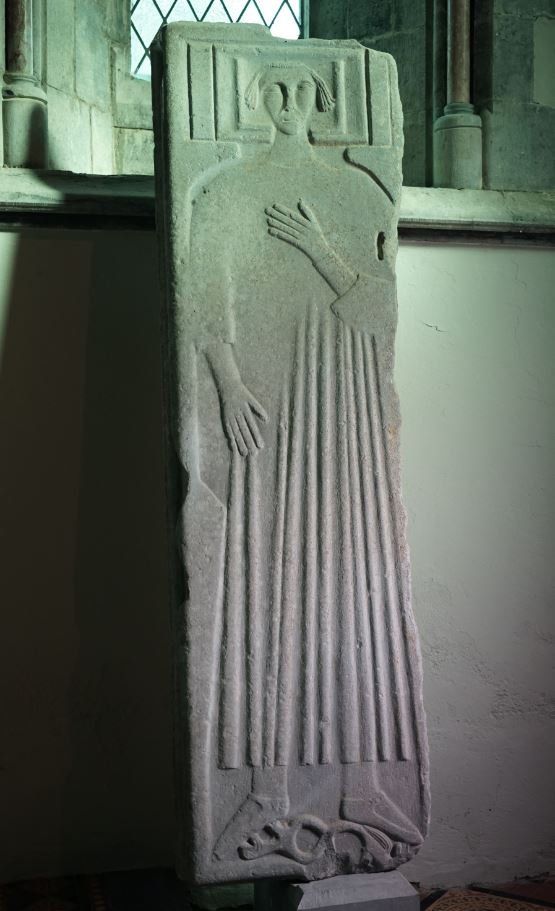1327 - the regency of Sir Roger Mortimer and Queen Isabella
Sir Roger Mortimer, Lord of Trim, was not in Ireland to witness the defeat of Edward Bruce
at the Battle of Faughart, and in the years that followed, he became a central figure in attempts to overthrow king Edward II. In 1323, Mortimer dramatically escaped from the Tower of London, where he had been imprisoned for treason, and fled to France. Shortly later he was joined by none other than Edward II’s queen, Isabella, daughter of Philip IV of France, who became Mortimer’s mistress. In September 1326, Mortimer arrived back in England with Queen Isabella and her young son Edward, and deposed Edward II, who died in captivity the following year. Queen Isabella and Mortimer were now co-regents, while the newly crowned Edward III was still only 14 years old. Though his position as co-regent was not officially recognised, Mortimer effectively ruled both England, Ireland and Wales as a king in all but name.
Gilbert de Clare, the 8th Earl of Gloucester died at the Battle of Brannockburn in Scotland in June 1314, shortly before Edward Bruce’s invasion of Ireland. He had been married to Maud de Burgh, daughter of the Red Earl of Ulster. They had no children, which brought an end to the de Clare line and meant that his vast estates in England, Wales and Ireland were divided amongst Gilbert’s sisters. Eleanor de Clare and her husband Hugh Despenser inherited the town of Kilkenny. They did not take an active role in the management of their Irish lands, so this job fell to his seneschal Arnold le Poer, defender of Alice Kyteler, who effectively ruled the town as if he were the lord himself. It was rumoured that Hugh Despenser was having an affair with his wife’s uncle, no less than king Edward II himself. With the fall of Edward II at the hands of Roger Mortimer and Queen Isabella, Hugh Despenser was next in line to be dispensed with. He was executed in a gruesome ceremony presided over by Mortimer and the Queen. By eliminating Despenser, Mortimer had also removed a man who might have established a lordship in Kilkenny to rival his own at Trim.
His title as Lord of Trim of course meant that Mortimer had financial interests in Ireland, and stability here would be important if he wished to maintain the profitability of these estates. However, Mortimer couldn’t risk leaving the side of the young Edward III and was not in a position to visit Ireland to take control of the situation here. So, he reached out to some of the most powerful men within the English colony in Ireland. The two men were James Butler and Maurice fitzThomas. In September 1328, Roger Mortimer convinced young Edward III to make him 1st Earl of March, and he soon contrived to have James Butler and Maurice fitzThomas similarly elevated.
We have already seen how John fitzThomas was awarded with the title of Earl of Kildare shortly before his death in 1316. In 1329, it was the turn of another branch of the Geraldines. Thomas fitzMaurice (d. 1213) was a son of Maurice fitzGerald, who arrived at Bannow in 1169. This Thomas had taken part in the invasion of west Munster
as a follower of William de Burgh. His son, John fitzThomas (not to be confused with the first Earl of Kildare), subsequently acquired extensive lands in Kerry, Limerick and Waterford. Many years later, his great-grandson, Maurice fitzThomas, inherited these lands and was quick to take advantage of the virtual collapse of the English royal government in Ireland after the Bruce invasion. In 1312, Maurice married Katherine, daughter of the Richard de Burgh, the Red Earl of Ulster. In January 1316, together with John fitzThomas (the soon-to-be first Earl of Kildare), Maurice fitzThomas was present at the Battle of Ardscull near Athy, in which Edward Bruce routed the Anglo-Irish forces that came to meet him.
In the years after the Bruce invasion, Maurice became involved in a bitter dispute over lands in Waterford with Arnold le Poer, who in 1324 had defended Alice Kyteler against the accusations of heresy from bishop Richard Ledrede. The crown forced Arnold and Maurice to make peace, but this lasted only a short while. Arnold le Poer, who had insulted bishop Ledrede in 1324, followed this three years later by calling Maurice fitzThomas a rhymer, in other words, a travelling poet. In the face of an enraged Maurice, Arnold fled to Waterford, and from there to England early in 1328. When he returned towards the end of that year, his old enemy bishop Ledrede was waiting for him. Ironically, the bishop brought fresh charges of heresy against Arnold, and he subsequently died while imprisoned and awaiting trial in Dublin Castle. The execution of Hugh Despenser in 1326 and now Arnold le Poer’s death, meant that Kilkenny was without both a powerful lord and a seneschal. This political vacuum would be filled, albeit gradually, by the Butler family.
The Butlers claimed descent from Theobald FitzWalter, who arrived in Ireland with Prince John in 1185. Theobald was the first chief butler in Ireland, from which the family derived their name. He had taken part in the conquest of Munster with William de Burgh, and had acquired lands in north Munster, centred around Nenagh, Co. Tipperary. Theobald fitzWalter also held lands in Leinster, that were granted to him by Lord John. The most important of these were the lands of Gowran, Co. Kilkenny, which provided the family with a foothold in Leinster that they would later use to expand their estates in Kilkenny.
Edmund Butler had been justiciar throughout most of the Bruce invasion, and had been present at the disastrous Battle of Ardscull in January 1316. In 1302, Edmund married Joan, daughter of John fitzThomas, who had also been present at the Battle of Ardscull and shortly afterwards was created first earl of Kildare. When Mortimer arrived in Ireland in 1317 as the king’s lieutenant, Butler relinquished responsibilities for the campaign against Bruce. Edmund Butler died in London in September 1321, apparently on his return from a pilgrimage to Santiago de Compostela, and in November his remains were interred at St Mary’s church in Gowran. He was succeeded by his son James, who Roger Mortimer seems to have considered a worthy ally. In 1327, Mortimer also arranged for James to marry Elinor de Bohun, a cousin of the young Edward III, and in November 1328, James was created 1st Earl of Ormond. The title of Ormond is effectively a corruption of the Irish Oir Mhumhain, which means east Munster, referring to the lands that the family held at that time in modern-day Tipperary.
On 27th August 1329, Maurice fitzThomas was created Earl of Desmond. The name derives from the Irish Deas Mhumhain, which means south Munster. In fact, much of fitzThomas’ estates were located in north Munster, but this name, Tuadh Mhumhain
or Thomond had been previously used by the Ua Briain who took it with them after they were forced north into Clare by the Anglo-Norman conquest of Munster after 1194. In this way, the name Desmond, which had lost its original meaning, was now used by Maurice fitzThomas to describe his estates throughout both north and south Munster.
In October 1330, on the eve of his 18th birthday, king Edward III decided the time had come to avenge the death of his father. The king had Roger Mortimer arrested and imprisoned in the Tower of London. On this occasion, Mortimer would not escape. At the end of November, during Parliament convened at Westminster, he was found guilty of numerous crimes, including the murder of Edward II. He was taken from the tower, forced to wear the black tunic he wore at Edward II’s funeral, and dragged by two horses to Tyburn, where he was hanged.
At face value, the impact of the regency of Mortimer and Queen Isabella might not seem obvious in an Irish context. After all, Mortimer was not even present in Ireland during his short-lived regency and had spent little time in the country since the end of the Bruce invasion in 1318. However, he was the only powerful man during this period who had substantial landholdings in Ireland as well as England and Wales. In 1330 he even engineered an expansion of the liberty of Trim to include much of Louth, and had he not alienated the young king, his direct influence in Ireland would likely have much more significant. However, by elevating both James Butler and Maurice fitzThomas to earldoms, Roger Mortimer changed the political map of Ireland for the rest of the late medieval period. Both Butler and fitzThomas had brought their respective families to the top of the social and political ladder, but the real game changers for the two men were the gifts that came with their respective Irish titles. Together with the earldom of Ormond, James was granted Tipperary as a liberty, and similarly Maurice was granted Kerry as a liberty as part of the earldom of Desmond. All who lived in these new liberties were now tenants of their respective earls, rather than directly from the crown. This was a significant change in policy that unraveled king John’s attempts to create an English-style shire system in Munster over a century earlier. Mortimer effectively removed large parts of Munster from direct control of the English crown and handed their administration to the earls of Desmond and Ormond.


